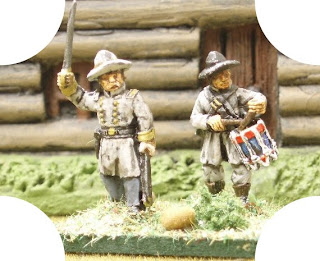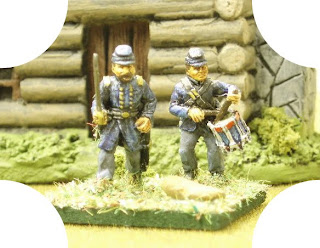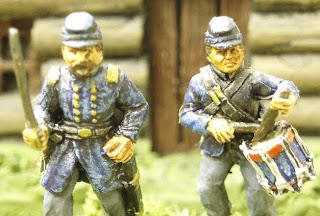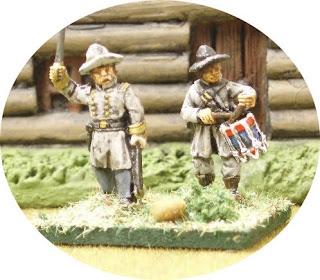 Union Movement Phase:
Union Movement Phase:OK – with three full descriptive moves behind us I think I owe you a break so I’ll cut down on the full description of all the modifiers going forward..
Union commander throws 7 for his brigade dice when deciding move distance.. which, with modifiers comes out as 9 – both units are disordered so check on the “Disordered Troops” part of the manoeuvre table.. they get “Rally” results, so they remove the disorder condition and can then move half..
- 14th Indiana: unit moves up on the 8th’s flank – mostly behind the wall.
- 8th Ohio: decides to stand behind the wall – no move.
Union Firing Phase:
Confederate Defensive fire:
- 2nd Virginia 4 bases – all firing at 8th Ohio
- 4th Virginia 5 bases – 1 base firing at 8th Ohio, the other four bases will fire at the 14th.
14th Indiana: 4bases/8 stands @ 3” - 6” range = 8 x 1FP = 8FP’s = +1 Modifier; -2 for the fact that they are (mostly) behind the wall plus a dice throw of 5 means they score 4 – no effect…
Union Offensive fire:
- 14th Indiana – all 4 bases will fire at 4th Virg.
- 8th Ohio 5 bases – 3 bases at 2nd Virg., the other 2 bases will fire at the 4th Virg.
Casualties:
4th Virg.: 6 bases/12 stands @ 3”- 6” (1FP) range = 12FP’s but four of the stands are disordered which ends up in a modifier of +2; D10 = 8 means they score 10 which results in a “Galling Fire” – further disorder, and another Confederate stand lost!
Some quite outstanding shooting by the Union troops and thereby hangs one of the issues with these rules - I'm no historical simulationist when it comes to my wargames - I know they're just games - but I do like to be able to rationalise the results I see when a dice is thrown; these single D10's introduce a massive range of possible results. DG and I have done away with it for the movement phase by using 2D10/2 but at the time I said I didn't want to do that for musketry, it's clear however that the dice is a massive part of the calculation - I may want to change my mind!
Union Charging Phase:
None..
Move 4 - Confederate Movement Phase:
Again, the Brigade Commander within 9” of both so they share the move dice
D10 = 6, which gives a modified result of 8. Both units are disordered so they both get a “rally” result – disorder removed and half move. The rebel yell rings out across the table as they both surge forward towards the enemy held wall …
Confederate Firing Phase:
Union Defensive fire:
7 bases at the 4th, 2 bases at the 2nd…
4th Virg.: 7 bases/14 stands @ 0 - 3” (1FP) = 14FP’s = +3 modifer, no other modifier, D10 =8, so result is 11! A “galling fire” – disordered, one stand removed, but still not enough to stop them…
Ouch!!
Confederate Offensive fire:
None – I reserve my fire for a “cold steel” bonus in the melee
Confederate Charging Phase:
In we go…
First combat was against 8th Ohio
+2 for fresh troops; -1 for trained troops;+1 for “cold steel”; -1 disordered; D10 = 2 – overall result of 3 (gulp….)
Union modifiers
+2 for fresh troops; -1 for trained troops; -1 disordered; +1 for the wall; D10 = 8 – overall result of 9..
A difference of 6 – the worst possible result! 2nd Virg. lose a stand and retreat a full move disordered… 8th OH hold.
Second combat against the 14th Indiana
+2 for fresh troops; -1 for trained troops;+1 for “cold steel”;-1 for a lost stand in the firing phase; -1 disordered; D10 = 3 – overall result of 3 (gulp….)
Union modifiers
+2 for fresh troops; -1 for trained troops; +1 for the wall; D10 = 2 – overall result of 4..
A difference of 1 – the attack falters, 4th Virg. move back a half move and end up disordered – no casualties
Definitely not what was wanted - looks like the Rebs left it too late to launch the attack, the concern now is that casualties are significant and the 2nd Virg. is now "worn" (due to the casualties)...
Position at end of move:






















